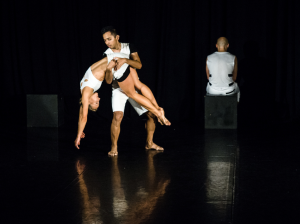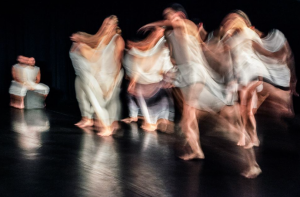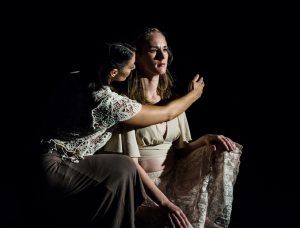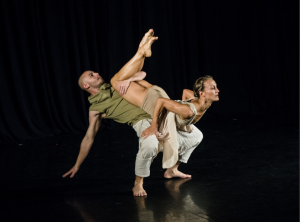Gorgeous Cascades of Movement in Malashock Debut
A deeply musical dancemaker, John Malashock has talked about choosing his music first and letting it inspire the choreography. Both the genius and the limitations of this process are on display in “Signatures II,” the Malashock Dance show that runs through November 13.

Justin Viernes and Andrea Rehm in “yKNOT.” Photo by Jim Carmody
Genius, first. For a number of recent dances, Malashock has picked contemporary classical music with wide-ranging moods, dynamics, and tempi, and it’s led to some of his richest, most complex work (e.g., the three pieces in “Lifeblood” in 2014). That’s the happy case with this program’s world premiere, “yKNOT.” set to several pieces performed by the sextet yMusic Ensemble.
“yKNOT” is described as focusing on dancers’ relationships in rehearsal, and at times they do get into knots, three or four or all eight of the dancers linking arms in intricate, fast-moving configurations. Playfully, they form conga lines with kitty-paw hands, exchange mock-punches, do tight staccato footwork with the flavor of a Balkan dance. A swoop-turn-wiggle combo made me think, “I wanna do that!”

“yKNOT” Photo by Raymond Elstad
Malashock deftly deploys groups around the stage and plays with unison and counterpoint in a cascade of ever-morphing movement. It’s like watching a gorgeous cloudy sky. (Raymond Elstad’s photo captures the feeling perfectly.)
It’s also a pleasure when the pace slows for a more extended duet titled “The Bear and the Squirrel.” Andrea Rehm is the withdrawn, hibernating bear, her face impassive, perhaps with depression or grief, while Justin Viernes clowns and tenderly tries to coax her into movement.
Elisa Benzoni’s costumes, a variety of mostly-white tops and bottoms, look great against the black space, which includes eight black cubes (about three feet on each side) around the periphery of the stage. At any time, dancers may be sitting on the cubes, often doing sequences of gestures—in one delicious phrase, they weave their hands in front of their faces, tilt sideways, and open their arms in an askew flutter.

Lara Segura and Blythe Barton in “Shadows of Mercy.” Photo by Jim Carmody
It was a joy, in “yKNOT,” to see the dancers sweat, especially since there was little visible sweating in the opening “Shadow of Mercy,” to songs by Leonard Cohen. It’s easy to see why Malashock would be drawn to Cohen’s mordant, literary songs, and he’s worked with them for years, first using a few in the 1990s and debuting the nine-song “Shadow of Mercy” in 2009.
While I’m a Leonard Cohen fanatic myself, the downside here is a relative sameness in tempo (moderate) and mood (bitter melancholy). That leads to a lot of sections in which Person A tries to connect with Person B—hovering beside B, sketching B’s outline with their hands—while B barely tolerates their presence.

Nicholas Strasburg and Andrea Rehm in “Shadows of Mercy.” Photo by Jim Carmody
“Shadow of Mercy” is beguiling, nonetheless. The songs lend themselves to storytelling, which works to juicy effect in “The Gypsy’s Wife,” where Lara Segura bullies Viernes, all the while giving the audience a conspiratorial smile. And the choreography features some acrobatic power moves, for which Malashock has the ideal dancer in rock-solid Nicholas Strasburg.
The venue, Malashock Dance’s Abbe Wolfsheimer Studio, is a nicely intimate setting … especially in a faster, all-male section of “Shadow of Mercy” when the men’s leaps almost take them into the laps of the front row.
“Signatures II” continues today at 4 and 7:30 p.m., November 10 & 11 at 7:30 p.m., and November 12 & 13 at 4:00 & 7:30 p.m. The location is the Abbe Wolfsheimer Studio, Suite 200 at Dance Place, 2650 Truxtun Road at Liberty Station.

Award-winning dance journalist Janice Steinberg has published more than 400 articles in the San Diego Union-Tribune, Dance Magazine, the Los Angeles Times, and elsewhere. She was a 2004 New York Times-National Endowment for the Arts fellow at the Institute for Dance Criticism and has taught dance criticism at San Diego State University. She is also a novelist, author of The Tin Horse (Random House, 2013). For why she’s passionate about dance, see this article on her web site, The Tin Horse
